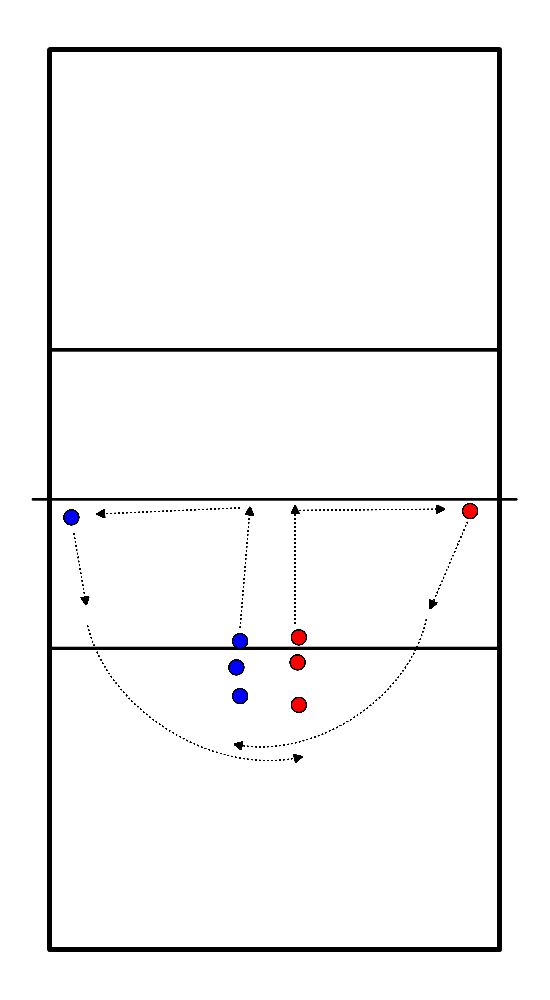Volleyball drills for technique block / net defense
- 2 people on a chair one with 2 tennis balls.
- other side of net must take blocks and tennis balls and pass to other person on chair -block-.
- 10x each
- One press on chair attacking each time, across net blocks and then dive at 3 meter line. Another "supplies" balls for person on chair. each 10x.
- Same as exercise 2. Now comes only a 2nd tip at about 5 to 6 meters. Defending facing the net!
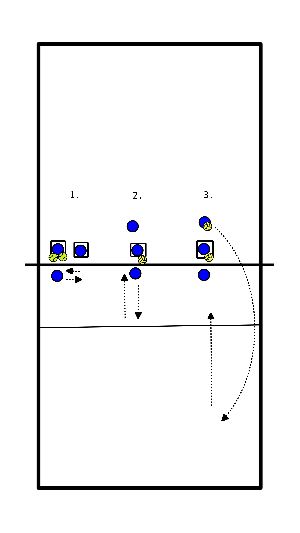
Running to the net and:
- Jump through; block and return. Slightly through the knees.
- Block with 1 lateral pass right and block again.
- Blocks with 1 side pass right and blocks and again to left side pass and block.
- Same as number 3 but then with Cross 'inside' right and again left.
- Info: if to right blocks start with your left leg, if to left blocks, start right leg.
- Same as number 3 but with Cross 'outside'.
- Info: if to right blocks right leg must also open to make your jump more powerful. reverse to left blocks.
- Block with 1 lateral pass right, idem to left. Straight inside cross, same to left. Straight outside cross, idem to the left.
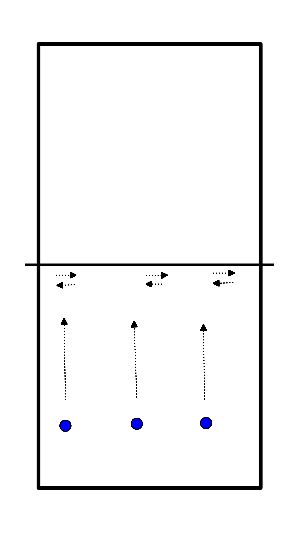
1. Player with ball holds it high, other player grabs ball in 'block' and back. 2x10 each.
2. Player with ball throws ball at +/- 20-30cm above the net, other blocks it back. 2x10 each.
3. Player with ball smashes ball, blocker anticipates attack ! 2x10 each.
2. Player with ball throws ball at +/- 20-30cm above the net, other blocks it back. 2x10 each.
3. Player with ball smashes ball, blocker anticipates attack ! 2x10 each.
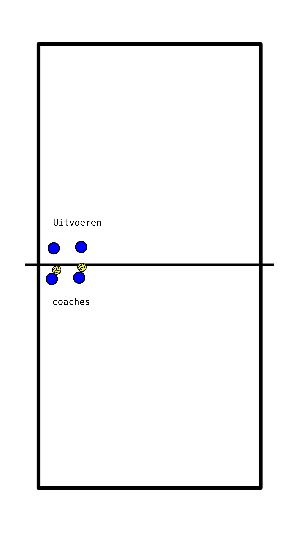
- The base team of six gets successively from the small team a serve, an attack -trainer plays rally ball the small team- and a free ball.
- The trainer plays rally ball on the small team and they play the ball back in one go.
The base team gets 3 attempts to score 3 balls in a row.
- If this succeeds, they rotate one spot.
- If this fails, the players from the small team switch with players from the base team.
The goal is to complete all rotations in the time the exercise is run.
- Service is made from position 5 on a pair; p/l & libero.
- After service, this person goes to defend at position 5.
- Side-out must be scored by attackers at position 3, 4 or 6.
- After the side-out, the coach hits balls from position 4 into the diagonal, which are defended by players at position 4, 5 and 6.
- From the defense again the attack must be scored. Rally is played out, after which everything starts again.
Points of attention:
- Block shields position 1 and 2. After the pass/defense cover -don't do nothing-.
- Make good choices in game distribution.
- Efficiency training: 20 balls 10 x service & 10x defense.
When everyone has had their turn in this way, we do the exercise in mirror image.
- Serve from position 1, block at position 3 and 4. Shield position 4 and 5.
- Defending at position 1, 2, 5 and 6.
- Attacking at position 1, 3 and 6.
At positions 2 and 4 are blockers, who close up the straight.
The middle players take turns "working".
The middle players take turns "working".
- Blocking at position 3 on the ball.
- Blocking on 4 on thrown ball, making space and attacking run on 3.
- Blocking on thrown ball on 3 and finally blocking on position 2 on hit ball.
The outside sides rotate through.
- After blocking, dive to the 3-meter line and join the strike.
- The one who struck goes to block, and so on.
- When the one who attacked steps in to attack, the outside blocker joins in.
After the middle players have all been 3 times, the outside players switch positions and another series of 3 follows.
- Libero in position 5.
- Ball is struck by SV 1 from position 4.
- SV 2 runs in from position 1 and has a choice of 3 attackers.
- Opposite 3 blockers or defenders.
- After the rally Tr. serves and attacks again.
- Then the playmakers change.
- Another attacker is played twice.
- Scoring 2x is 3 points, scoring 1x is 1 point and scoring 0x is exchange.
- Who will have 15 points first?
- Passer starts at position 5, with foot on the three-meter line.
- Ball is thrown up and hit from position 1 other side.
- When thrown up, the passer may move.
- Catcher runs in from position 4 to 2/3 and takes place on the mat.
- Pass on mat is 1 point, catcher then serves from 1 to 5.
- In the zone is 1 point, on the mat is 2 points.
- Then retrieve ball and attack.
- Whoever gets to 15 points first wins.
Variation
- Same, only now with 2 regular players, who take turns starting from position 4.
- An attacker is now added.
- The passer and passer make room for the new passer.
- The one who attacked serves again.
- The one who attacked goes to defend in the straight and then goes to block.
- The one who blocked becomes the reserve passer.
- Points can be gained by good pass, good service, score in attack or good defense, block can catch ball.
- Who will reach 20 points first?
- Base is butterfly with fixed SV.
- Two pass on side B.
- Player throws ball on two pass.
- Pass is P/L. possibly build out with middle attack.
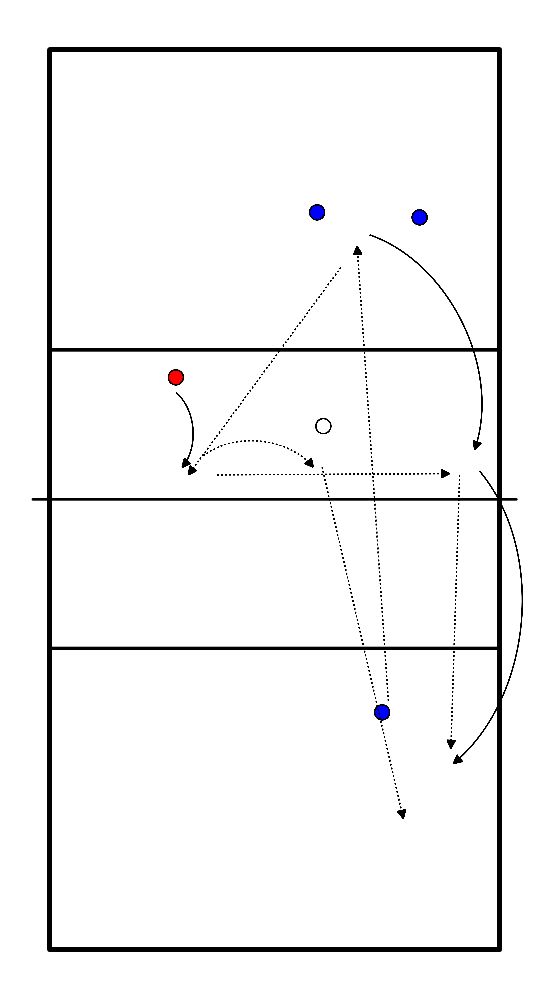
- This exercise is about the movement of the middle block and cooperation with the outside blocker.
- The ball is introduced through service or throw in (by the trainer or team-mate).
- Service is towards the passer.
- Passer brings the ball to the distributor.
- The distributor sets up the attack.
- After 10 attacks the game is continued.
- Players prefer to play on their own position.
- Important for the exercise:
- The playmaker communicates with his attackers about the desired attacking position and speed (especially the alternation between rise and short of the middle attacker).
- Mid block jumps with a rising attack (not full).
- If the ball goes outside, he lands on his left foot and moves outside to set up a two-man block (connecting).
- If the ball is played over middle, the outside blocker steps out to make a pass if the ball falls short or is hit.
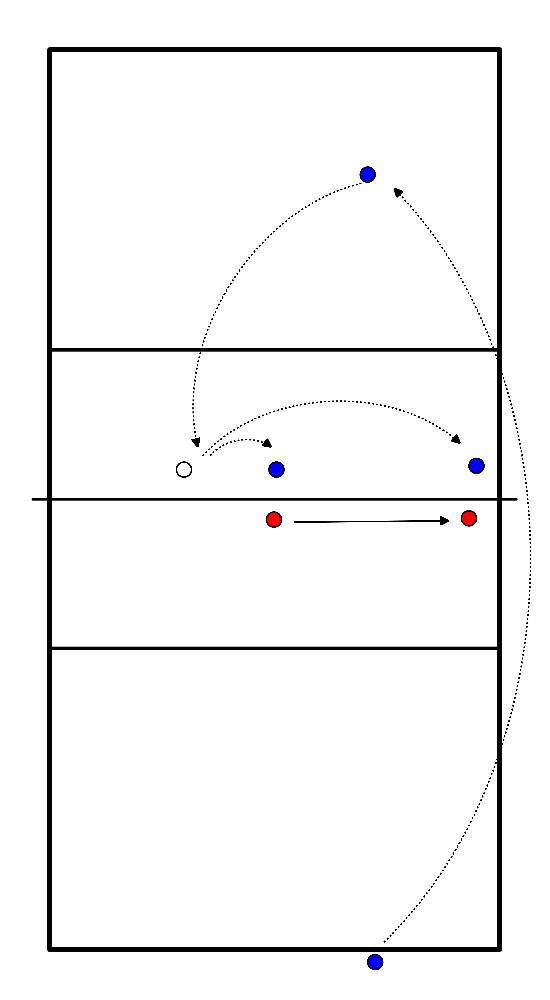
- Organization:
- Trainer throws to playmaker on p2/4 on field A.
- Every 5 setups the players are changed.
- On p4 an attacker stands at the net.
- On court B there is a blocker on p2 and a defender on p5.
- Execution:
- Trainer claps on the ball and throws to.
- The attacker walks back from the net at the moment of hit and attacks the setup on p4.
- She then runs back again and attacks a 2nd ball at p3.
- The block on field B moves with her to p3.
- Running directions:
- Attacker becomes block.
- Block becomes defense.
- Defense retrieves the balls and becomes attacker.
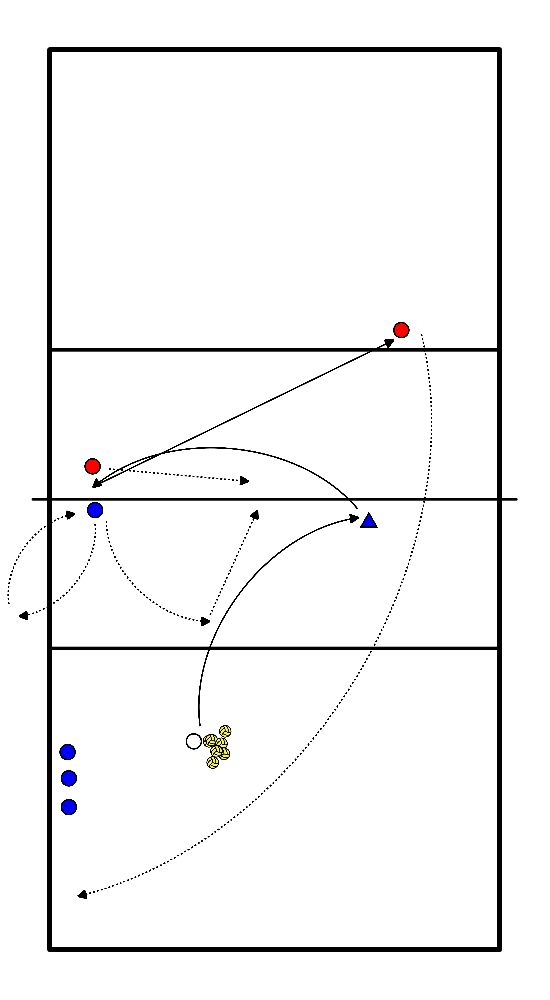
- Organization:
- Players on p2 and p4.
- Other players in 2 rows on 3m line p3.
- Execution:
- The first two players walk to the net and block together on p3.
- Then they sidestep or walk to p2 and p4 and block together with the player who is already there.
- The original player on p2 and p4 make a roll/dive and join the other row.
